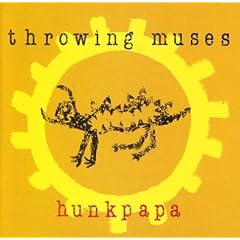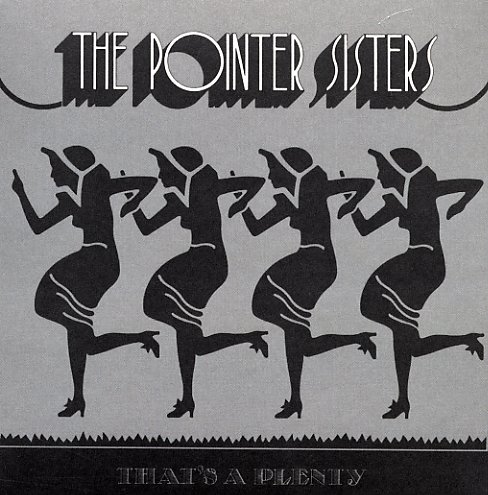Throwing Muses - Hunkpapa
Throwing Muses - Hunkpapa
by Gillian Watson

Hunkpapa is far from the highlight of Throwing Muses’ varied career. Almost universally panned, and disowned by head Muse Kristin Hersh, Hunkpapa saw the young band cajoled by their record company into straightening out their songwriting and adding glistening keyboards and horns that stood in stark contrast to the visceral, countrified post-punk of earlier albums, sounding tame in comparison. And yet I am constantly drawn back to it, perhaps moreso than any other Muses album.
We might put it down to nostalgia. Hunkpapa was my introduction to Throwing Muses; the odd melodies slowly wound their way around my head until I could anticipate every note, and now they tend to carry me away to seasons past. Yet Hunkpapa is the album that keeps on giving: interesting to approach cerebrally but still best experienced from the gut. Listening to it for the first time was a distinctly unsettling experience. This fourteen-year-old, who thought “Here Comes Your Man” was the epitome of punk, had no idea what make of this awkward conflation of commerciality and madness. The music reminded me of the budget country-and-western compilation they played in my parents’ favourite Ayrshire roadside café: dated, distant and yet recognisable; but the vocals were unmistakably out of the ordinary. Hersh sounded at once like a bitter, washed-up diva and a hopeful teenager, repulsive with the naked emotion and beguiling with cooing harmonies.
It was a while before I was able to pinpoint what fascinated and confused me so deeply: the confrontation between urban and natural soundscapes. Metallic clangs and horns collided awkwardly with sunshine yellow guitar; the imagery and melodic runs on “Bea” recalled rainy fields at night. This awkward combination was perhaps the natural conclusion of an evolution in sound which began with the barnlike echo of the Chains Changed EP and the panoramic sheen of House Tornado. Unfortunately the dark, disturbing nature of that album’s knife-like edge is dimmed by the sequel’s overproduction. On the first two records, nature is present in the music like day-to-day life in the countryside, and Hunkpapa is the country seen through a car window: a balance struck more successfully by “The Big Country” on Talking Heads 77. This uneasy balance between the urban and the pastoral struck a personal chord with me, a teenager who’d grown up in the city but with roots in the country. I found it difficult to reconcile the two sides.
By contrast, the commercial sound adds a delicious narrative to the band’s career: Throwing Muses vs. Sire Records, an age-old conflict to which any critic can quickly attribute Hunkpapa’s central flaw: the emasculation of the two bandleaders. The first time I listened to the album I noted with sadness that it was, well, girly. At the time I’d wondered how the Pixies could have toured with them, as I still unaware of their older albums, the ones that touched on unexplored backwaters of the female experience with toughness and energy. On Hunkpapa, the edges that made Hersh and Donelly one-offs rather than identikit girls-with-guitars are sanded away. Hersh’s voice swoops ethereally but rarely rasps. The effectiveness of her songs here are, at best, dulled by the production (“Mania”’s funny, vivid representation of bipolarity shakes out into an incoherent rave-up) and, at worst, rendered downright annoying (“The Burrow” sounds like a polite hoedown at a high school sleepover). Donelly’s “Angel”, while pretty, veers closer to Adult Contemporary than anything else in the band’s career.
Yet slicker production didn’t dull the band’s edginess completely, and intermittently serves to accentuate its angles here instead. Take the minimalism of songs like “Devil’s Roof”, which sounds almost like a mathematical formula for the Muses sound: Hersh’s cantering rhythm guitar, Donelly’s liquid leads that surface and disappear again like fish, Leslie Langston’s talkative bass and David Narcizo’s boxy drums. The clear, spacious production reveals the band’s individual personalities much more effectively than 1991’s colourful, but unfocused The Real Ramona. Look at the back cover: four wispy, thoughtful faces in sepia thumbnail prints. You could almost see them as a family on a day trip: Leslie quietly steering, David tapping on his knees, Kristin bitching and Tanya staring out of the window in a daydream. This almost dated notion of what makes a band “sell,” the presentation of the band members as personalities, as well as the glossy ‘80s production, makes it much more interesting as a quaint museum piece than 1995’s University, which led to more quantifiable success but is a lot less endearing.
Take away these arbitrary arguments why Hunkpapa is such a fascinating record. It’s ultimately no easier to analyse than any other Muses record listening to the songs themselves, which follow the wanderings of Hersh and Donelly intriguingly and resist artificial sweetening. Sure, the horns on “Take” are unnecessary, but listen to the dolorous, keening voices behind them. Every Throwing Muses song rests on the an idiosyncratic melody that worms its way in. You can only wonder to figure out why you like it; each time I tried to do so in this review, I came up against another dead end. I can’t fully explain why I fell for an album that goes against every beef I have with overproduction, and that the arists themselves have disowned. Kristin Hersh hates “Dizzy,” whose lyrics, rumour has it, she researched at a library. She has denounced it as a cynical move to appease the suits at Sire, that it came from her head and not her gut. She’d probably rather be remember solely for her authentic work. Tough. That’s her curse: even when she constructs a “stupid song” to appeal to the mainstream she comes out with touching music. The beauty of Hunkpapa: it transcends petty niggles about production values and “selling out.” After all, what was that critical stuff anyway?
Gillian Watson has written for What Was It Anyway?
by Gillian Watson

Hunkpapa is far from the highlight of Throwing Muses’ varied career. Almost universally panned, and disowned by head Muse Kristin Hersh, Hunkpapa saw the young band cajoled by their record company into straightening out their songwriting and adding glistening keyboards and horns that stood in stark contrast to the visceral, countrified post-punk of earlier albums, sounding tame in comparison. And yet I am constantly drawn back to it, perhaps moreso than any other Muses album.
We might put it down to nostalgia. Hunkpapa was my introduction to Throwing Muses; the odd melodies slowly wound their way around my head until I could anticipate every note, and now they tend to carry me away to seasons past. Yet Hunkpapa is the album that keeps on giving: interesting to approach cerebrally but still best experienced from the gut. Listening to it for the first time was a distinctly unsettling experience. This fourteen-year-old, who thought “Here Comes Your Man” was the epitome of punk, had no idea what make of this awkward conflation of commerciality and madness. The music reminded me of the budget country-and-western compilation they played in my parents’ favourite Ayrshire roadside café: dated, distant and yet recognisable; but the vocals were unmistakably out of the ordinary. Hersh sounded at once like a bitter, washed-up diva and a hopeful teenager, repulsive with the naked emotion and beguiling with cooing harmonies.
It was a while before I was able to pinpoint what fascinated and confused me so deeply: the confrontation between urban and natural soundscapes. Metallic clangs and horns collided awkwardly with sunshine yellow guitar; the imagery and melodic runs on “Bea” recalled rainy fields at night. This awkward combination was perhaps the natural conclusion of an evolution in sound which began with the barnlike echo of the Chains Changed EP and the panoramic sheen of House Tornado. Unfortunately the dark, disturbing nature of that album’s knife-like edge is dimmed by the sequel’s overproduction. On the first two records, nature is present in the music like day-to-day life in the countryside, and Hunkpapa is the country seen through a car window: a balance struck more successfully by “The Big Country” on Talking Heads 77. This uneasy balance between the urban and the pastoral struck a personal chord with me, a teenager who’d grown up in the city but with roots in the country. I found it difficult to reconcile the two sides.
By contrast, the commercial sound adds a delicious narrative to the band’s career: Throwing Muses vs. Sire Records, an age-old conflict to which any critic can quickly attribute Hunkpapa’s central flaw: the emasculation of the two bandleaders. The first time I listened to the album I noted with sadness that it was, well, girly. At the time I’d wondered how the Pixies could have toured with them, as I still unaware of their older albums, the ones that touched on unexplored backwaters of the female experience with toughness and energy. On Hunkpapa, the edges that made Hersh and Donelly one-offs rather than identikit girls-with-guitars are sanded away. Hersh’s voice swoops ethereally but rarely rasps. The effectiveness of her songs here are, at best, dulled by the production (“Mania”’s funny, vivid representation of bipolarity shakes out into an incoherent rave-up) and, at worst, rendered downright annoying (“The Burrow” sounds like a polite hoedown at a high school sleepover). Donelly’s “Angel”, while pretty, veers closer to Adult Contemporary than anything else in the band’s career.
Yet slicker production didn’t dull the band’s edginess completely, and intermittently serves to accentuate its angles here instead. Take the minimalism of songs like “Devil’s Roof”, which sounds almost like a mathematical formula for the Muses sound: Hersh’s cantering rhythm guitar, Donelly’s liquid leads that surface and disappear again like fish, Leslie Langston’s talkative bass and David Narcizo’s boxy drums. The clear, spacious production reveals the band’s individual personalities much more effectively than 1991’s colourful, but unfocused The Real Ramona. Look at the back cover: four wispy, thoughtful faces in sepia thumbnail prints. You could almost see them as a family on a day trip: Leslie quietly steering, David tapping on his knees, Kristin bitching and Tanya staring out of the window in a daydream. This almost dated notion of what makes a band “sell,” the presentation of the band members as personalities, as well as the glossy ‘80s production, makes it much more interesting as a quaint museum piece than 1995’s University, which led to more quantifiable success but is a lot less endearing.
Take away these arbitrary arguments why Hunkpapa is such a fascinating record. It’s ultimately no easier to analyse than any other Muses record listening to the songs themselves, which follow the wanderings of Hersh and Donelly intriguingly and resist artificial sweetening. Sure, the horns on “Take” are unnecessary, but listen to the dolorous, keening voices behind them. Every Throwing Muses song rests on the an idiosyncratic melody that worms its way in. You can only wonder to figure out why you like it; each time I tried to do so in this review, I came up against another dead end. I can’t fully explain why I fell for an album that goes against every beef I have with overproduction, and that the arists themselves have disowned. Kristin Hersh hates “Dizzy,” whose lyrics, rumour has it, she researched at a library. She has denounced it as a cynical move to appease the suits at Sire, that it came from her head and not her gut. She’d probably rather be remember solely for her authentic work. Tough. That’s her curse: even when she constructs a “stupid song” to appeal to the mainstream she comes out with touching music. The beauty of Hunkpapa: it transcends petty niggles about production values and “selling out.” After all, what was that critical stuff anyway?
Gillian Watson has written for What Was It Anyway?
Labels: Gillian Watson







